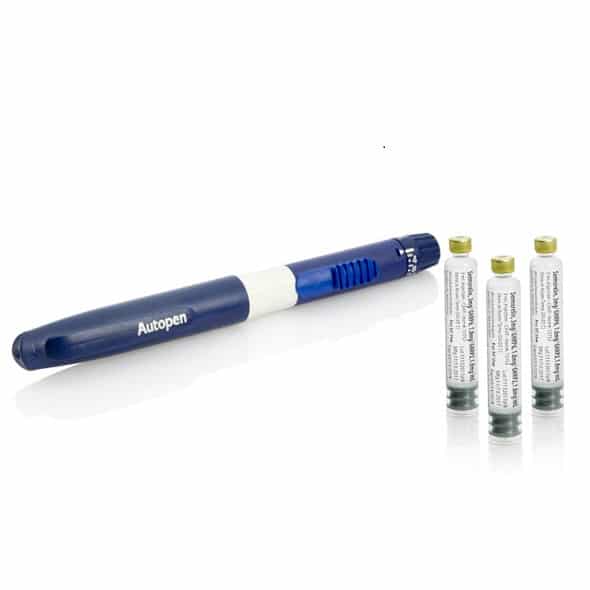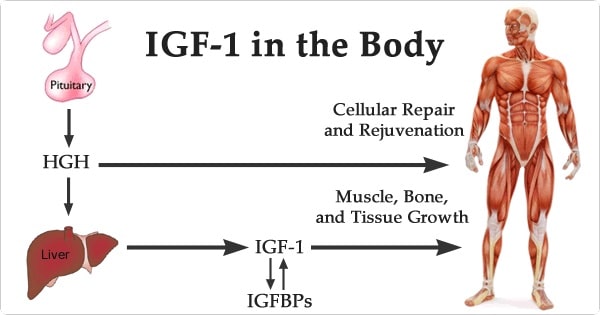
Growth Hormone and Exercise: Why Is Training So Important?
Table of Contents
- What Positive Effects Occur During Exercise in Various Tissues and Organs?
- The Benefits of Various Types of Exercise
- Which Exercises Are Most Effective for Maximum HGH Secretion?
- Recommendations for Physical Activity Levels by Age (Across the Lifespan)
- Additional Heath Benefits of Increased HGH Through Exercise
HGH deficiency (also called growth hormone deficiency or GHD) is a common medical condition that often develops in adults later in life. Hormone replacement therapy (HRT) can safely and effectively boost circulating HGH levels. However, for the maximum sustained benefit, individuals with GHD must also get regular exercise to keep HGH levels where they need to be for optimal health.
Here is everything that you should know about the connection between HGH levels and exercise, which workout programs produce the greatest HGH spikes, and appropriate activity levels for different age groups.
What Positive Effects Occur During Exercise in Various Tissues and Organs?
Exercise produces a cascade of beneficial physiological effects in the body that extends to nearly every tissue and organ. Here is a breakdown of what occurs during exercise in different parts of the body:
- Muscles. Through chemical and neurological signaling, glycogen (stored sugar) is pulled out of the muscles to be used as fuel during exercise. In the absence of adequate glycogen stores, an alternative energy source called adenosine triphosphate (ATP) is also used to power movement. The lungs and heart begin to work harder to pump more oxygen-rich blood to the muscles that require it. If the exercise is properly intense and strenuous, the movements will create tiny rips in the muscle fibers. This is what causes post-workout muscle soreness, also known as delayed-onset muscle soreness (DOMS).
- Bones. Exercise, especially heavy lifting workout programming, increases bone density and strength. In the elderly, most often at risk of weakening bones (osteoporosis), exercise substantially reduces the risk of injury from falls.
- Joints. Intense, heavy workouts can put 5-6 times the strain that normally occurs in everyday life onto the joints., including the knees, elbows, shoulders, hips, ankles, and wrists. Without enough protective collagen production – which HGH stimulates – the wear-and-tear can deteriorate joint integrity.
For the maximum sustained benefit, individuals with GHD must also get regular exercise to keep HGH levels where they need to be for optimal health.
- Hormones. Prolactin, cortisol, testosterone, and HGH levels spike during exercise. Luteinizing hormone (LH) increases in the post-workout phase. Peptide hormones, the building blocks of HGH, are also secreted during exercise.
- Emotions. Exercise at any intensity level significantly improves mood as well as combatting chronic mental health conditions such as depression and anxiety while simultaneously improving self-confidence and self-esteem.
- Brain. Due to increased output of the heart and lungs, more nourishing, oxygenated blood reaches the brain. This stimulation creates myriad benefits inside of the structure of the brain, including “turning on” good genes and “turning off” the expression of negative ones. Hormonal chain reactions result in large quantities of endorphins pumped into circulation – the neurotransmitter hormone that triggers the “runner’s high.”
The Benefits of Various Types of Exercise
Different types of exercise produce different benefits for improved physical performance and overall health. Here is a breakdown of common types of training and their impacts on health:
- Aerobic training. Commonly referred to as “cardio” for “cardiovascular training,” aerobic exercises tests the body’s ability to oxygenate its muscle tissues when constant pressure is applied by demand from struggling muscles. Common examples of cardio are walking, bicycle riding, and swimming. The biggest benefits of regular cardio for health are improved immune function, better stamina by way greater lung capacity and more efficient heart function, and improved metabolism (fat burning), even during rest.
- Flexibility training. The term “flexibility training” encapsulates any exercise that improves the ability of muscle fibers, tendons, and ligaments to stretch without causing damage. The applications for flexibility training are diverse; yoga practitioners practice flexibility training on their mats while, in more clinical settings, physical therapists rely on sophisticated tools and technologies to help their patients improve flexibility. Regardless of the form, flexibility training reduces chronic pain, improves posture, balances mood and emotions, and results in fewer injuries for practitioners,
- Balance training. Some individuals struggle with balance more than others. Balance training can help. Certain pieces of equipment in the gym, such as a Bosu, specifically target balance. Tai Chi is a popular practice from the Far East that can improve balance. Yoga, primarily a flexibility/meditation technique, also incorporates balance training into its regimen. Balance training improves mobility, prevents joint injuries, and optimizes reflexes and hand-eye coordination and, potentially, neuroplasticity.
- Resistance Training (Strength Training). A medium to high-intensity weightlifting session is just what the doctor ordered for improved well-being, especially for balancing hormones. HGH release skyrockets during resistance training. Other benefits of strength training include increased bone density, muscle development (with increased protein synthesis), positive neurochemical adaptations, boosted metabolism, and higher-quality sleep.

All of the exercise categories we explored above will raise HGH, but if maximum HGH secretion is your goal, then you should absolutely include strength training in your regular routine – especially as you age. Studies have shown that as little as one strength training session per week is adequate to produce positive hormonal changes, including higher HGH levels. Many exercise programs, such as high-intensity interval training (HITT), incorporate aspects of both balance, flexibility, cardio and strength training.
Why Workout Intensity Matters
The goal of your fitness program should be to push your limits regularly in terms of the intensity that you put into your workouts. As you bump up the intensity of exercise, you gain the following benefits:
- Greater improvements in lung capacity and heart function.
- Greater improvements in blood sugar regulation.
- Improved hormone response, including greater HGH and testosterone gains.
Which Exercises Are Most Effective for Maximum HGH Secretion?
The most effective exercises for optimizing your HGH secretion are the ones that typically involve short bursts of maximum effort punctuated by brief 1–3-minute periods of rest.
Examples of the most effective HGH-boosting exercises include:
- Weightlifting. Frills aside, weightlifting is the time-tested “gold standard” of HGH-enhancing workout routines. Especially for men who want to get the most out of the muscle-building properties of HGH, you can’t go wrong with a steady diet of bench press, squats, and deadlifts.
- High-intensity interval training (HIIT). Next to weightlifting, HIIT might be the best type of exercise for boosting HGH. The clinical evidence shows that shorter workouts with bursts of extreme exertion followed by intervals of rest produce the greatest HGH increases. HIIT fits the bill.
- Burpees. Burpees have moved from the prison yard to the corporate office gym because they incorporate most of the major large muscle groups (important for HGH stimulation) in a single easy-to-perform motion, including aspects of bench press and squats. The major benefit of burpees is that they can be done anywhere without the need for any equipment.
- Box jumps. Box jumps strengthen the core while working the entire set of muscles in the leg, home to the largest muscle groups in the body. Explosivity training exerts a beneficial impact on a number of health and fitness markers, including higher HGH levels.
The most effective exercises for optimizing your HGH secretion are the ones that typically involve short bursts of maximum effort punctuated by brief 1–3-minute periods of rest.
- Running. Although it is less effective than high-intensity strength training, aerobic or “cardio” exercise does produce modest HGH gains. If you are doing cardiovascular exercise such as running as your preferred method of physical activity, consider doing it in a fasted state for maximum hormone benefits (see section below for more info on fasting, exercise, and HGH).
- TRX. TRT, the acronym for Total Resistance Exercises, is a primarily strength-training exercise program that utilizes a suspension system to combine gravity and bodyweight as the oppositional forces. TRX also has mobility and balance benefits for those who practice it. Because it is a resistance training tool, TRX does benefit HGH levels.
- CrossFit. CrossFit, as the name might imply, contains multiple elements that are “crossed” into a single program, including interval training, powerlifting, aerobic exercise, and gymnastics. CrossFit has a wide array of benefits, including moderate HGH gains for those who practice it.
The Connection Between HGH and Exercise
What does growth hormone do during exercise and how does it facilitate the process? The substantial gains in circulating HGH triggered by exercise are well-documented. This phenomenon is called the “exercise-induced growth hormone response (EIGR)” as a way to explain the synergistic relationship between physical performance and HGH levels.
According to the science, “the exercise-induced growth hormone response (EIGR) is well recognised and although the exact mechanisms remain elusive, a number of candidates have been implicated.” The known drivers of HGH gains in the human body that are experienced during physical exertion include:
- Neural input.
- Direct stimulation by catecholamines.
- Lactate and or nitric oxide.
- Changes in acid-base balance.
IGF-1, HGH, and Exercise
Researchers actually attribute much of the muscle protein-stimulating effects of exercise not to HGH directly, but to a closely related molecule called insulin-like growth factor-1 (IGF-1). The liver manufactures and releases IGF-1 according to stimulation by HGH. Lower HGH levels results in lower IGF-1 levels; conversely, higher HGH concentrations result in greater circulating IGF-1 levels.
IGF-1 is a critical anti-aging tool because it supports healthy protein synthesis (a pre-condition for muscle growth) across the lifespan – including for older individuals at risk of sarcopenia, or age-related muscle loss. Specifically, IGF-1 targets the rapamycin (mTOR) pathway that is closely linked with a healthy, graceful aging process. The bottom line is that the exercises discussed in this article, in addition to supporting HGH, also improve IGF-1 levels for bigger, stronger muscle long into old age.
A Note on Intermittent Fasting, Fasted Workouts, and HGH
The practice of intermittent fasting (IF) calls for regular pauses of caloric intake for extended time periods. The most common form of IF is called the 16:8 method, meaning that you eat for 8 hours each day, then pause for a 16-hour period (8 of which are usually spent asleep). The daily routine then resets and the cycle restarts. The chart below, based on clinical data, illustrates how IF supercharges HGH secretion over a 24-hour fasting period – more effective than any exercise or supplement you can buy over the counter.
As you can see, even a brief fast can boost HGH levels three-fold.
Best of all, when you exercise in a fasted state, HGH production increases even further. For this reason, if possible, you might want to begin regularly exercising while fasted. The most convenient time of day that many people find to include a fasted workout in their daily schedule is first thing in the morning.
Exercise and COVID: A Concerning Drop in Activity Levels
Before the 2020 coronavirus pandemic shut down regular social life, Americans did not get enough exercise on average. Unfortunately, the social distancing and economic shutdown measures have further worsened the trend. The chart below shows how far physical activity levels have fallen since early last year.
Because regular exercise enhances the innate immune system – your body’s frontline defenses against COVID-19 and other pathogens – maintaining your activity levels is more critical now than ever before.
Recommendations for Physical Activity Levels by Age (Across the Lifespan)
How much physical activity you require to get into better shape — including by stimulating greater HGH production — depends on a number of factors. Age is an important metric when considering your activity levels. The CDC has provided guidelines for exercise by age, illustrated in the chart below:
| Exercise time (minutes per week) | Ideal Types of Exercise | Extra Considerations | |
| Preschool-Aged Children (3-5 years) | Should stay active throughout the day. | Any physical activity is acceptable. | |
| Children and Adolescents (6-17 years) | 420 (60 minutes per day) | Variety of vigorous activity including sports, running, climbing, jump rope, push-ups, and gymnastics. | |
| Adults (18-64 years) | 150 | At least 2 days (20 minutes each) of strength training. | 150 minute per week is the minimum and not the limit; stay as active as possible. |
| Older Adults (65 years and older) | 150 | · At least 2 days (20 minutes each) of strength training.
· Balance training. |
150 minute per week is the minimum and not the limit; stay as active as possible. |
Additional Heath Benefits of Increased HGH Through Exercise
Physical activity produces greater HGH concentrations which, in turn, improve physical fitness. This is a synergistic, win-win for your hormone health that makes the pairing of physical activity with higher HGH levels an unrivaled combination.
The additional benefits of more HGH through exercise include:
- Visceral fat (belly fat) burning. HGH shreds visceral fat, the type that accumulates around the midsection (most prominently in aging bodies).
- Muscle building. HGH is an anabolic hormone, meaning that it promotes healthy tissue development, including muscle growth. Earning gains in the gym is impossible without enough HGH and its partner hormone IGF-1.
- Improved mental health. HGH is critical for optimal mental health. Among the many negative mental health effects of GHD, researchers now suspect that HGH deficiency may be linked to schizophrenia. On the other hand, even patients without significant mental health issues prior to receiving HGH therapy report improved cognition as well as better mood and overall mental outlook.
To naturally boost HGH with simple lifestyle changes, regular exercise — on its own or as a complement to HGH replacement therapy — is the best method to produce long-term hormonal shifts that improve quality of life.


